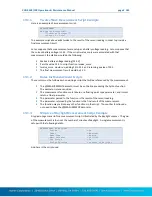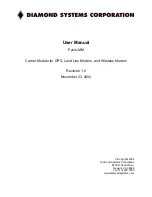
XLINK 500/100 Operations & Maintenance Manual page # 166
For more information on SDI-12, go to
17.2.
Wiring Guidelines
SDI enables you to connect up to 10 sensors with as many as many as 9 parameters each. The
interface is implemented using three wires: data, ground, and +12V. The ground conductor of the
SDI interface line should be large enough to keep the voltage drop between the data recorder
and the sensor to less than 0.5 volts during the maximum sensor current drain. Failure to observe
this specification will cause bad communications and/or bad data. The maximum current used on
the +12V line should not exceed 0.5 amps at any time.
17.3.
Connector
The connector type is not part of the SDI specification. Make sure to connect all three lines: SDI-
12 Data, SDI-12 PWR, and GND. Multiple sensors can be connected to a single connector.
17.4.
Setup of SDI sensors
Each SDI-12 sensor has an address from 0 to 9. This address differentiates one sensor from
another. Most sensors are factory default set to address zero (0). If/when interfacing more than
one sensor, each sensor must be assigned a unique address. This is normally done by setting dip
switches on the sensor or by software commands. Failure to set unique addresses for each
sensor will result in failure of the communications interface (i.e. no data logged). Consult the
sensor manufacturer’s data for information on your particular sensor(s
).
When setting up multiple SDI-12 sensors, connect one sensor at a time. Once a new sensor is
connected, you must give it a unique address. To do so, either use LinkComm or the command
line. Type SDI-12 FIND to detect new sensors. Once a sensor is found, change its address by
typing SDI xAy!, where x is the old address, A is A, and y the new address. For example, SDI 0A1!
will change the address from 0 to 1.
When getting more than one parameter from a single sensor, be sure to set the measurement
schedules the same. When the station finds multiple parameters from a single sensor (same
address), it will only issue a measurement of the sensor once, then read each of the parameters
from the one measurement. This is important to ensure that data from one sensor is gathered at
the same time and for sensors that have multiple parameters that take a long time to process.
17.5.
Useful SDI commands
Resetting the address by software (some sensors) is normally done by sending the aAb!
command. (a A b !, where a is the current address of the sensor you want to change and b is the
address you want to change to, e.g., 0A5! changes the address of sensor 0 to address 5.)
Another useful SDI-12 command is the aI! (where a is the address of the sensor, e.g., 3I! for
sensor at address 3) command. 4I! will return an identification string from the sensor at address
4, which includes the SDI version number, vendor's name, sensor model number, sensor version
number, and serial number. This is a quick way to see if the sensor is responding properly.
A way to verify data collection (manual data collection) is to issue the aM! command. For
example, 7M! would collect data from the sensor at address 7. The sensor will respond with a
5-digit code -- the first digit is the address, the next 3 digits are the required time for
















































